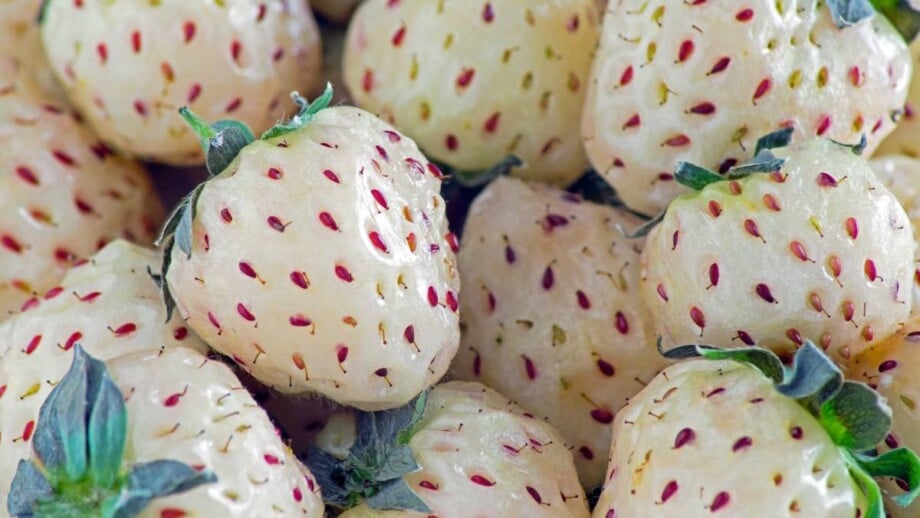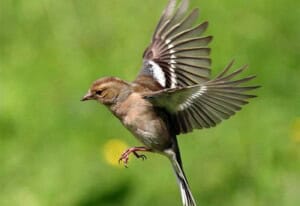Pineberry plants produce delicious berries that have a distinct aroma and pineapple-like flavor but look like white strawberries with red seeds. These delicious berries are native to two cities in Chile and were then bred in the Netherlands and became commercially available in 2010.
Since these plants cannot be grown from seeds but only from runners, initially they were incredibly difficult to get hold of and everyone wanted to grow them! Thankfully, we now have reliable sources to get pineberry bare root plants to grow them in our very own gardens.
If you have experience growing common garden strawberries, then growing pineberries will be a breeze since care and maintenance for these plants is quite similar!
Botanical Name: Chiloensis
Common Name: Pineberry, Pineberries, Purén White Strawberry, Ananaserdbeere
Family: Rosaceae
Plant Type: Fruiting perennial
Hardiness Zones: 4 – 8 (USDA)
Sun Exposure: Full sun
Soil Type: Loamy, rich, well-drained soil
Soil pH: Slightly acidic (5.5 – 6.5)
Height: 6 to 12 inches
Spacing: 18 to 24 inches
Bloom Time: Late spring, early summer
Native Area: Chile
Quick Guide: Planting, Growing & Caring for Pineberry Plant
- Plant pineberries in full sun
- Keep well watered but not waterlogged
- Pineberries require slightly acidic, rich, loamy soil
- When the berries start to form, mulch with straw
- Common pests include spider mites, aphids, and slugs.
Affiliate Disclosure: Planet Natural editors review and select each product mentioned in the article independently. If you buy through affiliate links, we may earn a commission which will help support our website.
As an Amazon Associate we earn from qualifying purchases. Some links may be affiliate links. We may get paid if you buy something or take an action after clicking one of these links.
What is a Pineberry?
The term ‘pineberry’ which combines the words ‘pineapple’ and ‘strawberry’ describes a relatively recent cultivar of light pink or light orange to white strawberries that are adorned with red achenes.
Pineberries, like the modern Garden Strawberry (Fragaria x ananassa), are a cross between the wild South American Fragaria chiloensis (found in the wild in some parts of Chile) and the North American Fragaria virginiana.
Some people believe that the pineberry fruit was created through genetic engineering, but in reality, it was developed through a process of natural cross-pollination.

History of Pineberries
Pineberries were first discovered by Spanish explorers and botanists, who called them “chili” and described them as a delicious and simple-to-eat berry-like fruit. This is how they got their botanical name Chiloensis.
They are the oldest known strawberry and one of the two strawberries responsible for the development of the modern strawberry. They grow wild and are grown organically in a part of Chile called the Mananal, which is a protected mountain range area that looks out over the ocean.
They bloom in this region during the winter and are associated with the holidays. Farmers sell their freshly picked pineberries at farmer’s markets and other similar events.
When Dutch horticulturists found the Pineberries’ original source material in France, they were able to start growing the fruit commercially.
Small-scale commercial crops were made available in the Netherlands after six years of diligent research and development, and they are now also grown in the UK in climate-controlled greenhouses.
Pineberry Plant Care
If you have experience growing red strawberries, then you’ll easily be able to grow pineberries, as these white strawberries require similar care and maintenance.
The pineberry is a low-growing groundcover that resembles the common garden strawberry in that it has runners, or trailing vegetative growth. The plant is virtually identical to other types of strawberry plants, right down to the delicate, white flowers it bears in the spring.
However, the pineberry fruit itself is little small, white strawberries with red seeds when they’re ready to be harvested.
Light
Pineberries require a lot of sun, so make sure you grow them in a location that gets at least six hours of direct sunlight per day. Since these plants are perennial, it’s important to keep in mind that they will be in this spot for a long time, so choose wisely.
Soil
Pineberries will thrive in rich, fertile soil that has been amended with compost or manure. Pineberries have shallow roots like strawberries, and they favor soil that is slightly acidic. They will grow optimally in soil with a pH between 5.5 and 6.5. Ensure that they are planted in soil with adequate drainage, as they do not like to be waterlogged.
Water
It’s important to keep the soil moist but not wet and soggy. Drip irrigation systems are preferable but not required. Ensure that the soil has adequate drainage, as your pineberry plants will not thrive if it becomes waterlogged. In the late fall, you should reduce watering to help your plants get ready for the winter.
Temperature and Humidity
Pineberry plants prefer cooler temperatures with an average of 70 degrees Fahrenheit and low humidity levels. Plants dislike high summer temperatures, humidity, and strong drying winds.
Fertilizer
Pineberries, which are ever-bearing, benefit from a dose of high-phosphorus and potassium fertilizer every two to four weeks. Ensure that you do not apply fertilizer when it is extremely hot outside, as this could further stress already-stressed plants.
Don’t use fertilizers that have too much nitrogen, as this can make plants grow bigger but weaker. Reduce the amount of fertilizer as the temperature begins to cool, as we want to harden the plants before winter arrives.
Mulching
Mulch the pineberry bed with straw after you’ve planted your pineberry plants. This reduces weed growth, lowers soil temperature, and keeps fruit cleaner by keeping pineberries away from the mud. When the danger of frost has passed in early spring, remove the mulch.

How to Plant and Grow
Site Preparation
Site preparation is particularly important when planting a pineberry patch as the plants will remain in the same spot for years.
Choose a sunny, weed-free location that’s south-facing if possible, and make sure it’s away from trees and other shade-producing plants.
It’s also a good idea not to plant them in soil that’s previously been used to grow peppers, tomatoes, or eggplants. This is because these plants have the potential to spread harmful pathogens like Verticillium Fusarium wilt, Phytophthora, and other fungi-caused diseases into the soil, which are bad for pineberries. Unfortunately, these pathogens can survive in the soil for up to four years.
Pineberries need constant moisture but don’t like standing water as they can easily get waterlogged. They prefer rich sandy loam that is well-drained but with good water retention.
Poor-draining, clay soils can be easily improved with organic peat moss or coconut coir and other organic materials.
Plants do best with a pH reading between 5.5 and 6.5, meaning the soil should be slightly acidic. Test your soil in the fall before planting and add dolomite lime if the soil is too acidic and pH needs raising.
If the soil is too alkaline, use elemental sulfur to raise the level. A week or so before setting out plants, apply a balanced fertilizer to the patch.
How to Grow Pineberries from Seeds
Unfortunately, you can’t grow pineberries from seeds.
Pineberries are a hybrid plant, and as with all hybrids, you can save the seeds, but you will likely not get the results you desire if you plant them.
The seeds will germinate, but they will not produce pineberries. When hybrid seeds are sown, the plant that grows tends to take on the characteristics of one of its parents.
There was a time when pineberry plants were hard to come by but everyone wanted to grow them, and thankfully now that they’re widely available.
These days, you shouldn’t have any trouble tracking them down, and they would make a wonderful addition to your berry garden. However, you must start with plants rather than seeds if you want to grow pineberries.
Please refrain from purchasing pineberry seeds if you see them being sold on Amazon or elsewhere. Even if they were grown from actual pineberries, it is unlikely that they would produce white strawberries.
Yes, this also means that seeds collected from pineberries purchased at farmer’s markets will not produce pineberry plants.
How to Get Pineberry Plants for Propagating
Despite the fact that pineberry plants are becoming more and more popular, most garden centers are unlikely to carry them. You’ll probably need to place an order from a specialized nursery or reliable sources who already grow them in order to get them.
There are also many new varieties available, such as White Carolina, White Pine, White Albino, Wonderful, Natural Albino, and White D. All of these kinds can be found in North America. Occasionally, plants are called pineberry without a variety name.
Moreover, keep in mind that there are white alpine strawberry varieties available. Contrary to popular belief, these tiny white berries are not pineberries but rather ripe wild strawberries.
The berries are very small, and when they are ready, the seeds will be yellow. They don’t have much flesh and have too many seeds.
Pineberries can be purchased from Hirts Garden Store in the US which sells on Amazon, and Thompson & Morgan, J. Parkers, or Crocus in the UK. Again, make sure you’re purchasing plants rather than seeds, and always read the reviews.
How to Plant Pineberries
Planting pineberry plants in your garden is easy. Start by digging a hole as deep as the roots and twice as wide. Make a mound of soil at the bottom of the hole so that the top of the mound is level with the surrounding soil.
Spread the roots of the plant down the sides of the mound, then loosen the soil around the plant to allow for the successful rooting of the runners.
Backfill the hole with soil, lightly compacting it to prevent air pockets. Avoid compacting the soil at this time and instead immediately water the area to settle the soil.
Put a layer of mulch such as straw, leaves, pine needles, or compost around your pineberry plants. Mulch will assist in maintaining a cooler soil temperature around the plant roots, which will assist your plants in producing more fruits.
Common Pests and Plant Diseases for Pineberry Plant
Pineberries are vulnerable to numerous potential diseases, such as gray mold, viruses, root rots like red stele and black root rot, fruit rots like anthracnose, and foliage diseases like leaf spot and scorch.
Insect pests include tarnished plant bugs, spider mites, aphids, leafrollers, slugs, nematodes, and strawberry weevils.
Other Articles from Planet Natural:
How to Grow Strawberries: The Complete Home Gardener’s Guide











